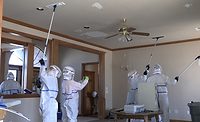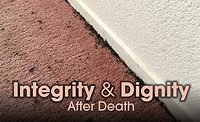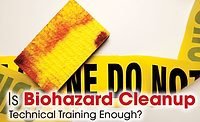Suiting Up: Forensic Restoration PPE


Rolls of various materials stacked in a factory in China to be converted into PPE.

Head-to-toe PPE, including breathing protection from least protection to best.

William “Dean” Kirk inspects some of the suits as they’re being made.

William “Dean” Kirk inspects some of the suits as they’re being made.





The term PPE, or Personal Protective Equipment, refers to protective clothing, respirators, goggles, hard hats, gloves, and other garments or equipment worn to protect an individual from injury and harm.
The history of PPE dates back to ancient times when soldiers would suit up for battle. One of the first large-scale PPE uses was in World War I, when PPE was used to protect soldiers from the chemical gases such as mustard gas. In the forensic restoration industry, PPE has evolved and will continue to change to be able to protect the operators in the field against microbial warfare.
Disposables have become an integral part of many industries today. They are everywhere from the local deli to the high-tech electronic clean rooms, and while industries use some of the same materials, there are many differences.
Identifying & Choosing Materials
There are four major types of nonwoven materials most common to the today’s industries: Tyvek, microporous film, SMS (Spun-bonded-Melt blown-Synthetic), and polypropylene.
Tyvek
Dupont founded Tyvek under the research efforts of William Hale Charch in 1944. Dupont scientists found a way to shred and process nylon fibers to create a form of synthetic paper. Still, it wasn’t until 1961 that Tyvek actually emerged on the market.
Polypropylene
Polypropylene, a major nonwoven polymer in today’s market, was developed in 1954 by Guilio Natta. It was put into production in 1957 and there have been many improvements on polypropylene materials since its inception. Three of the modifications are with film coatings, PE coated polypropylene, microporous film, and SMS.
Microporous Film
Microporous film is a polypropylene membrane that is thermally laminated to a polypropylene nonwoven material. This was developed in 1987 through improved processing of polypropylene and came into the commercial market in 1993.
SMS
SMS is another derivative of polypropylene that is made up of three layers: two layers of polypropylene thermally bonded together with a thin poly membrane that is perforated.
Choosing and identifying the right materials can be difficult. These materials are used in several other industries and one of the largest users is the industrial safety sector. Their application is to protect the user from biological matter, blood, mold, asbestos, chemicals, and foreign substances getting on themselves or their clothing.
Best Options for Restoration Companies
For Non-Hazardous Jobs
Restoration and remediation companies have several challenges when choosing the correct PPE for a restoration project. Most will use an SMS or polypropylene fabric in a lab coat, coverall, bouffant cap, shoe covers, sleeves, and masks. SMS gives good protection for fluid resistance and hold out while still achieving a breathable comfort level. Polypropylene is used in areas where protection is not critical, such as dusty or dirty areas free of hazardous materials. This is the most breathable and comfortable option.
SMS and polypropylene have varying filtration rates since the thickness of the material instead of the composition of the material determines the amount of protection. The average thickness of SMS ranges from 45 gsm (grams per square meter) to 55 gsm or 1.4 oz (ounce per square yard) to 1.8 oz. The filtration rate is 10 microns for a 55 gsm garment versus 30 microns for a 45 gsm garment. SMS will shed liquids for a period of time depending on the thickness of the material, but it is not a complete barrier. This makes SMS a very desirable material because it is breathable and will give adequate protection over a period of time. Polypropylene is the least protective of the materials and has a hold out range of 50 to 70 microns based on material weights of 45gsm to 30gsm or 1.4 oz to 1.0 oz. Many operators use polypropylene or SMS where there is minimal exposure within the work area for brief periods of time.
For Hazardous Jobs
When operator safety is especially critical, microporous film and Tyvek fabrics are the best route. Tyvek and microporous film materials will yield the highest particulate filtration efficiency. Tyvek will filter out dry particles up to 0.03 microns. The microporous film material has a barrier coating to allow for a low filtration rate at .01 microns, but lacks in comfort because it is not breathable. It works well in areas that are constantly wet and optimum protection is needed. Both of these materials will be hot to wear in most situations. When optimum protection is needed though, these materials work extremely well. With more precautions set forth for biological use, the sewn seams on these materials present a break in the barrier. There are versions of micropourus film that have sealed taped seams. Using Tychem SL and QC garments that have sealed taped seams allows for optimum protection.
The Investment
Tyvek, since one company makes the material, is consistent in gsm weight, but microporous film, SMS, and polypropylene, vary in price by weight and size and there are many different manufactures/converters of these materials. These materials are non-wovens that are sold by weight as rolled goods and then converted to an isolation gown, lab coat, coverall, or shoe cover. This means the price of a 1.4 oz lab coat versus a 1.8 oz lab coat can vary in price by 20% and can vary even more depending on the size cut the garment has. The industrial sector usually wants the cheapest form of protection since it goes to their bottom dollar cost. The difference is a compromise in quality, weight of material, and durability can cost an operator their health or life. There are several ways to make sure you are getting what you need.
Microporous film is a complete barrier with the coating. It is meant as an alternative to Tyvek. Sizing and gsm weight is what affects the cost of this material. SMS and polypropylene weights can be looked at in several ways. First is comparing the thickness to another garment as well as weighing the garment itself. You can ask your supplier for the manufactures SDS sheets on the materials, which should always specify the weight of the material. The cut size and durability of the garment also reflect the quality. How does the garment hold up and does it fit right for the marked size of the garment? When ever you look at these materials in any form, lab coat, coverall, look at the stitching and the cut of the overall garment. You will be able to see many differences from one garment to another.
The decision to use one disposable or another option will ultimately come down to price, quality, application, and the end user. Choosing the right one can be difficult sometimes, but application and risk assessment is the best way to start. Once you know your options are compatible with the type of work you’ll be doing, you can compare the garment specifications from one product to the next and pricing to make a final purchase decision.
Looking for a reprint of this article?
From high-res PDFs to custom plaques, order your copy today!










